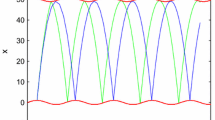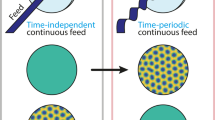Abstract
Possible constitutive models are examined for the formation of a herd, under the assumption that a herd forms a travelling wave while grazing. Under quite general conditions, it is found that the only possibility for a travelling wave is a balance between food seeking and natural dispersion, such as in chemotaxis. The stability of the travelling wave previously conjectured, is shown both for one- and two-dimensional perturbations.
Similar content being viewed by others
References
Adler, J.: Chemotaxis in bacteria. Ann. Rev. Biochem. 44, 341–356 (1970).
Keller, E., Segel, L.: Travelling bands of chemotactic bacteria. A theoretical analysis. J. Theor. Biol. 30, 235–248 (1971)
Odell, G., Keller, E.: Travelling bands of chemotactic bacteria revisited. J. Theor. Biol. 56, 243–247 (1976)
Scribner, T., Segel, L., Rogers, E.: A numerical study of the formation and propagation of travelling bands of chemotactic bacteria. J. Theor. Biol. 46, 189–219 (1974)
Kennedy, C. R., Aris, R.: Travelling waves—A simple population model involving growth and death. Bull. Math. Biol. 42, 397–429 (1980)
Author information
Authors and Affiliations
Rights and permissions
About this article
Cite this article
Gueron, S., Liron, N. A model of herd grazing as a travelling wave, chemotaxis and stability. J. Math. Biology 27, 595–608 (1989). https://doi.org/10.1007/BF00288436
Received:
Revised:
Issue Date:
DOI: https://doi.org/10.1007/BF00288436




